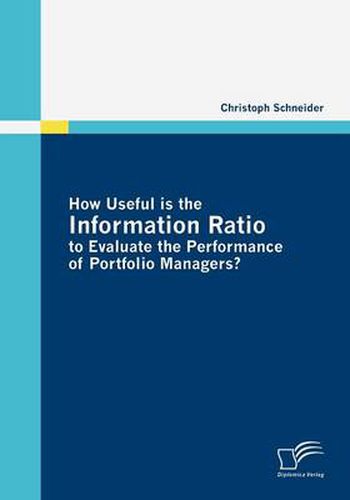Readings Newsletter
Become a Readings Member to make your shopping experience even easier.
Sign in or sign up for free!
You’re not far away from qualifying for FREE standard shipping within Australia
You’ve qualified for FREE standard shipping within Australia
The cart is loading…






This title is printed to order. This book may have been self-published. If so, we cannot guarantee the quality of the content. In the main most books will have gone through the editing process however some may not. We therefore suggest that you be aware of this before ordering this book. If in doubt check either the author or publisher’s details as we are unable to accept any returns unless they are faulty. Please contact us if you have any questions.
The idea of comparing the performance of different risky investments, for example investment funds, on a quantitative basis dates back to the beginnings of the asset management industry and has been an important field of research in finance since then. Performance measures serve as valuable quantitative evidence for the portfolio manager’s performance as well as for the evaluation of investment decisions ex post. Based on the idea of the capital asset pricing model proposed by Treynor, Sharpe and Lintner, Treynor developed the first quantitative performance measure intended to rate mutual funds, the Treynor Ratio. Since then, a large number of performance measures with very different characteristics have been developed. In addition to their power of rating investments ex post, their ability to predict future performance has been thoroughly analyzed by Grinblatt & Titman, Brown & Goetzmann, Carhart and others. Besides academia, the driving force behind the development of more sophisticated performance measures has always been the investors. This is understandable, as the truly poor managers are afraid, the unlucky managers will be unjustly condemned, and the new managers have no track record. Only the skilled (or lucky) managers are enthusiastic . By combining and applying the results of previous research to a new sample of nearly 10,000 mutual funds that invest in different countries and asset classes, this thesis clarifies its central research question: Is the Information Ratio a useful and reliable performance measure? In order to answer this central question, it has been split up into the following sub-parts: What are the characteristics of a useful and reliable performance measure? What actually is good performance? Is the good performance a result of luck or of skilled decisions and does it persist over time? How does the Information Ratio compare to other performance measures, and what are its strengths and weaknesses? This empirical study aims at answeri
$9.00 standard shipping within Australia
FREE standard shipping within Australia for orders over $100.00
Express & International shipping calculated at checkout
This title is printed to order. This book may have been self-published. If so, we cannot guarantee the quality of the content. In the main most books will have gone through the editing process however some may not. We therefore suggest that you be aware of this before ordering this book. If in doubt check either the author or publisher’s details as we are unable to accept any returns unless they are faulty. Please contact us if you have any questions.
The idea of comparing the performance of different risky investments, for example investment funds, on a quantitative basis dates back to the beginnings of the asset management industry and has been an important field of research in finance since then. Performance measures serve as valuable quantitative evidence for the portfolio manager’s performance as well as for the evaluation of investment decisions ex post. Based on the idea of the capital asset pricing model proposed by Treynor, Sharpe and Lintner, Treynor developed the first quantitative performance measure intended to rate mutual funds, the Treynor Ratio. Since then, a large number of performance measures with very different characteristics have been developed. In addition to their power of rating investments ex post, their ability to predict future performance has been thoroughly analyzed by Grinblatt & Titman, Brown & Goetzmann, Carhart and others. Besides academia, the driving force behind the development of more sophisticated performance measures has always been the investors. This is understandable, as the truly poor managers are afraid, the unlucky managers will be unjustly condemned, and the new managers have no track record. Only the skilled (or lucky) managers are enthusiastic . By combining and applying the results of previous research to a new sample of nearly 10,000 mutual funds that invest in different countries and asset classes, this thesis clarifies its central research question: Is the Information Ratio a useful and reliable performance measure? In order to answer this central question, it has been split up into the following sub-parts: What are the characteristics of a useful and reliable performance measure? What actually is good performance? Is the good performance a result of luck or of skilled decisions and does it persist over time? How does the Information Ratio compare to other performance measures, and what are its strengths and weaknesses? This empirical study aims at answeri